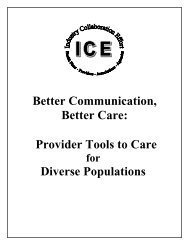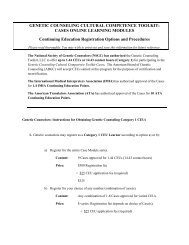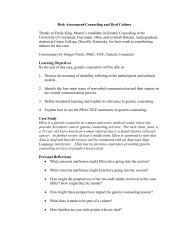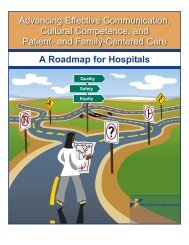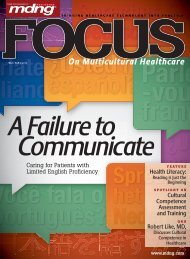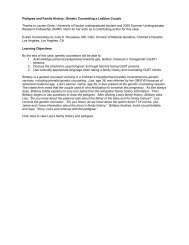making the business case for culturally and linguistically appropriate ...
making the business case for culturally and linguistically appropriate ...
making the business case for culturally and linguistically appropriate ...
You also want an ePaper? Increase the reach of your titles
YUMPU automatically turns print PDFs into web optimized ePapers that Google loves.
INTRODUCTIONHighlights:• Overview of U.S. demographic changes <strong>and</strong> implications <strong>for</strong> health careorganizations;• A brief description of how <strong>the</strong> government identified CLAS as a priority, <strong>and</strong>how this was translated into a series of 14 st<strong>and</strong>ards <strong>for</strong> health careorganizations;• An explanation of <strong>the</strong> state of CLAS in health care; <strong>and</strong>• In<strong>for</strong>mation about <strong>the</strong> origin <strong>and</strong> goals of this <strong>business</strong> <strong>case</strong> study project.The U.S. Census has shown a consistent increase in immigrants <strong>and</strong> LEP populations in <strong>the</strong>past 20 years, <strong>and</strong> experts <strong>for</strong>ecast a dramatic increase in <strong>the</strong>se populations over <strong>the</strong> next 20-40 years. Census experts estimate that by 2050 <strong>the</strong> proportion of "minorities" in <strong>the</strong> U.S. willapproach <strong>and</strong> perhaps exceed 50 percent. The rapid increase in population diversity bringswith it both opportunities <strong>and</strong> challenges <strong>for</strong> health care organizations. For example, <strong>the</strong>numbers of racial <strong>and</strong> ethnic minorities, immigrants <strong>and</strong> LEP populations enrolled in U.S.health plans has increased. 4 The fact that health plans have increased enrollment among LEPpopulations brings with it a responsibility to meet <strong>the</strong> language <strong>and</strong> cultural needs of <strong>the</strong>senew patients.Government Activity Supporting CLAS in Health CareThe Office of Minority Health (OMH), U.S. Department of Health <strong>and</strong> Human Services, wasm<strong>and</strong>ated in 1994 by <strong>the</strong> United States Congress (P.L. 101-527) 5 to develop <strong>the</strong> capacity ofhealth care professionals to address cultural <strong>and</strong> linguistic barriers to health care delivery <strong>and</strong>increase access to health care <strong>for</strong> people with limited or no English proficiency. In 1998, <strong>the</strong>U. S. Department of Health <strong>and</strong> Human Services rein<strong>for</strong>ced its commitment to health care <strong>for</strong>all by establishing a Healthy People 2010 objective to eliminate health disparities amongracial <strong>and</strong> ethnic populations in America. 6Subsequently, OMH in 2000 published <strong>the</strong> National St<strong>and</strong>ards <strong>for</strong> Culturally <strong>and</strong>Linguistically Appropriate Services (CLAS) in Health Care. The document included a set ofnational st<strong>and</strong>ards spelling out legal <strong>and</strong> regulatory requirements <strong>for</strong> <strong>the</strong> provision of healthservices to individuals with limited English proficiency. 1 The report outlined 14 voluntaryCLAS st<strong>and</strong>ards organized by three <strong>the</strong>mes: <strong>culturally</strong> competent care (St<strong>and</strong>ards 1-3);language access services (St<strong>and</strong>ards 4-7) <strong>and</strong> organizational supports <strong>for</strong> cultural competence(St<strong>and</strong>ards 8-14). See page 11 <strong>for</strong> a list of <strong>the</strong> CLAS st<strong>and</strong>ards. The st<strong>and</strong>ards wereestablished to systematically change <strong>and</strong> advance access <strong>and</strong> provision of health care services<strong>for</strong> minority <strong>and</strong> non-English proficient populations. The goals of <strong>the</strong> CLAS st<strong>and</strong>ards are toimprove <strong>the</strong> health of all Americans by aiming to eliminate racial <strong>and</strong> ethnic healthdisparities, address <strong>the</strong> inequalities that currently persist in health care, <strong>and</strong> to make healthcare programming more adaptable to <strong>the</strong> needs of <strong>the</strong> individual patient.4 Planning Culturally <strong>and</strong> Linguistically Appropriate Services: A Guide <strong>for</strong> Managed Care Plans. Summary.February 2003. Agency <strong>for</strong> Healthcare Research <strong>and</strong> Quality, Rockville, MD.5 About <strong>the</strong> Center of Cultural <strong>and</strong> Linguistic Competence in Health Care;http://www.omhrc.gov/templates/browse.aspx?lvl=2&lvlID=166 Healthy People 2010; http://www.healthypeople.gov/9


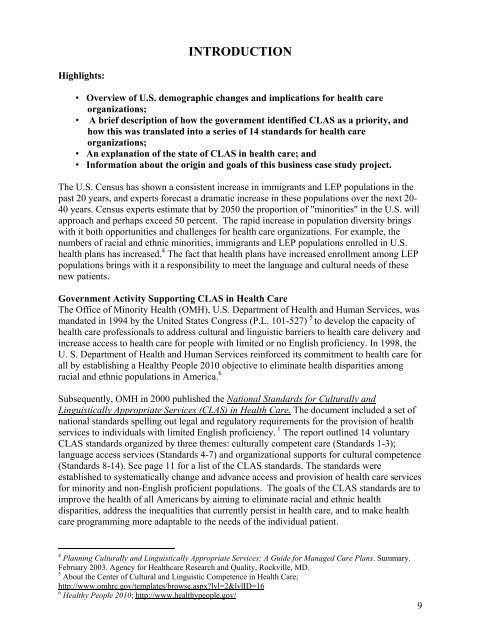
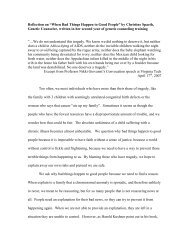
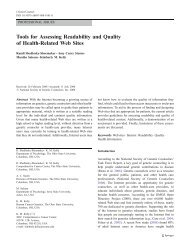

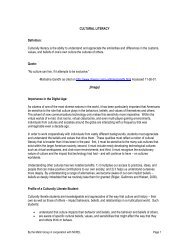
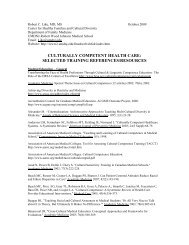

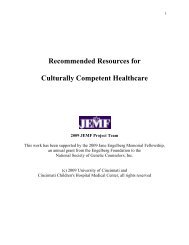
![Breaking Bad News PPT[1] - Genetic Counseling Cultural ...](https://img.yumpu.com/35003134/1/190x146/breaking-bad-news-ppt1-genetic-counseling-cultural-.jpg?quality=85)
